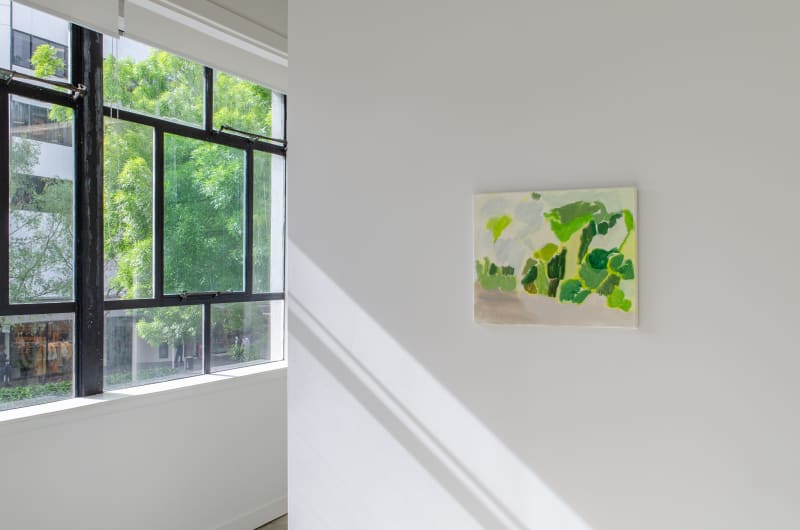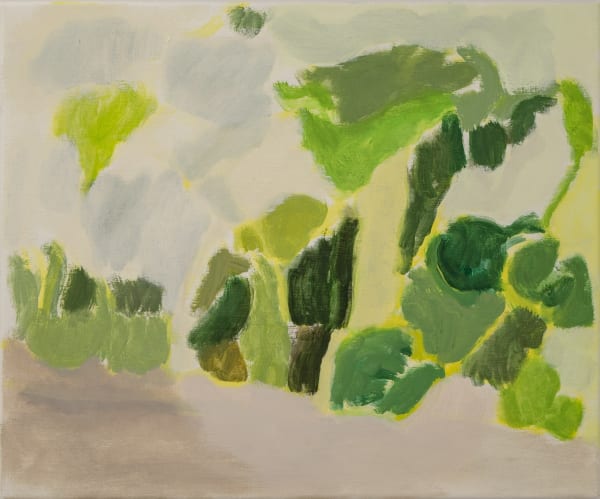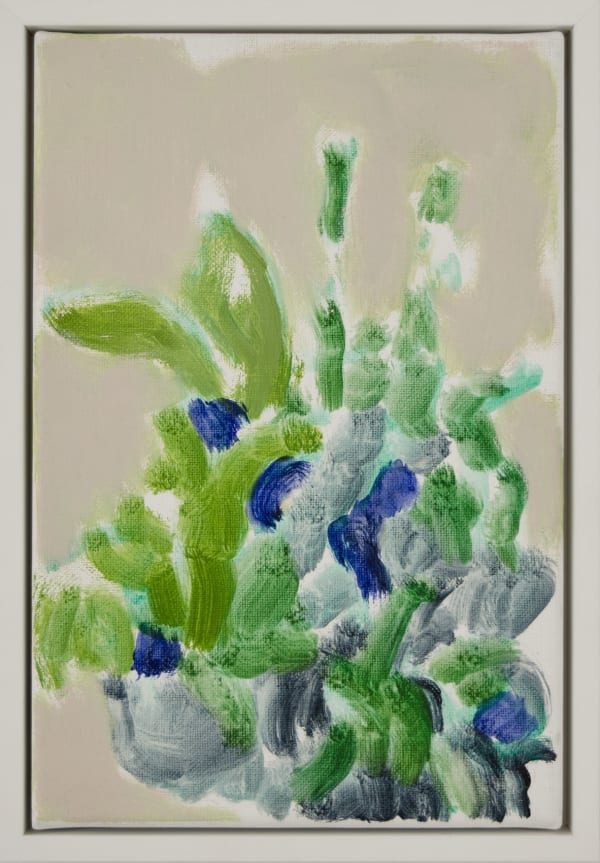Rebecca Hasselman, In the back garden
“To garden you must think ahead, be gentle, be ruthless, consider depth and the path of the sun. To be a gardener is to know what it means to fail, to put something in the wrong spot and watch it battle valiantly, then meekly, and then curl. Sometimes it is to be so flamboyantly optimistic – with only hope or irrational boldness to go on – only to lose it all in a late flurry of snow.
To be a painter is to know these things too. And to paint gardens requires a quiet resolution. To return to the same subject over and over, as one returns to the studio again and again. Rebecca Hasselman’s paintings remind me of the places you find yourself talking on the phone when the sun goes down or watching a child scrabble about in the back door dust. They are from her garden in Dunedin, yet they evoke so many others.
I look at these works and see faint remnants of Hasselman’s childhood in Glenorchy, the colours and the dryness – and the sparseness that comes with that – and the scrubbiness that is ever present.
Her painting is careful yet self-assured. Consistently – almost defiantly – modest in scale, they are landscape as still life, mild explosions, and fine gestures. At times she is brusque in application, but always generous, joyful, in colour. Just when you think it might get frilly, she pares it back with an economy of materials, a delight in brevity.
It is this astute observation and indexing of the interior and exterior, of the close and the obscure, that demonstrates Hasselman’s capacity to both paint her specific experience while quietly nudging the viewer to see certainty and flux anew and all around. They are like a note on an envelope, a photograph from a hot summer’s day, a single brave flower. And that is enough.”
Rebecca Hasselman (b.1989) graduated from Ilam School of Fine Arts at Canterbury University in 2014. She lives with her young family in Ōtepoti Dunedin.
Extract from the exhibition essay by Holly Best. The full essay accompanies the exhibition and is below.
On Clouds and Umbels
Holly Best
One night in the back garden a horse got loose, and my mother lay awake for hours thinking it might be a man thrashing about in the dark.
And on another night, I left all my dolls out on the broken pergola, and they were rained on. As I wrung their heavy taupe bodies out and lay them to dry, I thought I might just be the worst mother in the world and I whispered I’m sorry, I’m sorry, into their jasmine covered hair.
And when one easter the big Doberman next door ate the chocolate eggs hidden in the garden my mother said she hoped it died — and maybe she meant it. But we spied on that neighbour and her nasty dog, watching her garage door go up and down, because she often got her remote controls confused.
I liked to tear the agapanthus leaves into long sticky strips, to spar with their big bluish umbels, then wear them as a fancy hat. I liked to go in to battle with a red hot poker, and get married with the white arum lilies, their long yellow spikes staining my tee shirt.
I dug a hole and lined it with polythene for the tadpoles from the school fair and they evaporated.
I pushed our grey girl cat in a cane pram up and down the path, and up and down the steps, and around the bird bath. She wore a doll’s frock and little white shoes.
The old lady from the other next door had a pretty, slanting lawn, and we would lie on our sides, gripping our ribs and roll all the way down and into the hedge. You could hear my mother through our back door frying onions. And sometimes we rode our green trike down that lawn, our legs up in the air, until we eventually flew off and got grass clippings all up our backs and in our hair.
And there was an enormous blushing azalea, and my mother took a picture of me in a leotard, looking into the sun.
And out at the clothesline the smell of mint, crushed under our feet.
***
To garden you must think ahead, be gentle, be ruthless, consider depth and the path of the sun. To be a gardener is to know what it means to fail, to put something in the wrong spot and watch it battle valiantly, then meekly, and then curl. Sometimes it is to be so flamboyantly optimistic — with only hope or irrational boldness to go on — only to lose it all in a late flurry of snow. It is to notice the first sign of disease. It is to corral a symphony of unpredictable individuals with their preferences and enemies on to a hostile stage and ask them to play their part — and act natural. You must cover things (but only lightly) and watch, and wait, and come back to the same problem.
To be a painter is to know these things too. And to paint gardens requires a quiet resolution. To return to the same subject over and over, as one returns to the studio again and again. Rebecca Hasselman’s paintings remind me of the places you find yourself talking on the phone when the sun goes down or watching a child scrabble about in the back door dust. They are from her garden in Dunedin, yet they evoke so many others. They have a sense of possibility: of looking out a window into the day or standing in the doorway — knowing you probably won’t venture out, for there are other things to do — but of the chance that is there, reassuringly there.
I look at these works and see faint remnants of Hasselman’s childhood in Glenorchy; not because they reflect that prodigious landscape, but it is the colours and the dryness — and the sparseness that comes with that — and the scrubbiness that is ever present. Her interest in the underlying structure or geometry of a landscape might come from playing in the mountains, or it might now be from a gravel path meeting a passing cloud of her motherhood in Dunedin.
Her painting is careful yet self-assured. Consistently — almost defiantly — modest in scale, they are landscape as still life, mild explosions, and fine gestures. At times she is brusque in application, but always generous, joyful, in colour. Just when you think it might get frilly, she pares it back with an economy of materials, a delight in brevity.
It is this astute observation and indexing of the interior and exterior, of the close and the obscure, that demonstrates Hasselman’s capacity to both paint her specific experience while quietly nudging the viewer to see certainty and flux anew and all around. They are like a note on an envelope, a photograph from a hot summer’s day, a single brave flower. And that is enough.
Rebecca Hasselman (b.1989) graduated from Ilam School of Fine Arts at Canterbury University in 2014. She lives with her young family in Ōtepoti Dunedin. Recent exhibitions include: The sunlight lies down across everything (2021) with Georgina May Young, Olga Gallery, Ōtepoti Dunedin; Group Exhibition (2020) with Tyne Gordon and Andrea Bolima, Jhana Millers Gallery, Te Whanganui-a-Tara Wellington; Suspended Terrain (2019) Toi Pōneke Gallery, Te Whanganui-a- Tara Wellington.
In the back garden is Rebecca Hasselman’s first solo exhibition with Jhana Millers.












